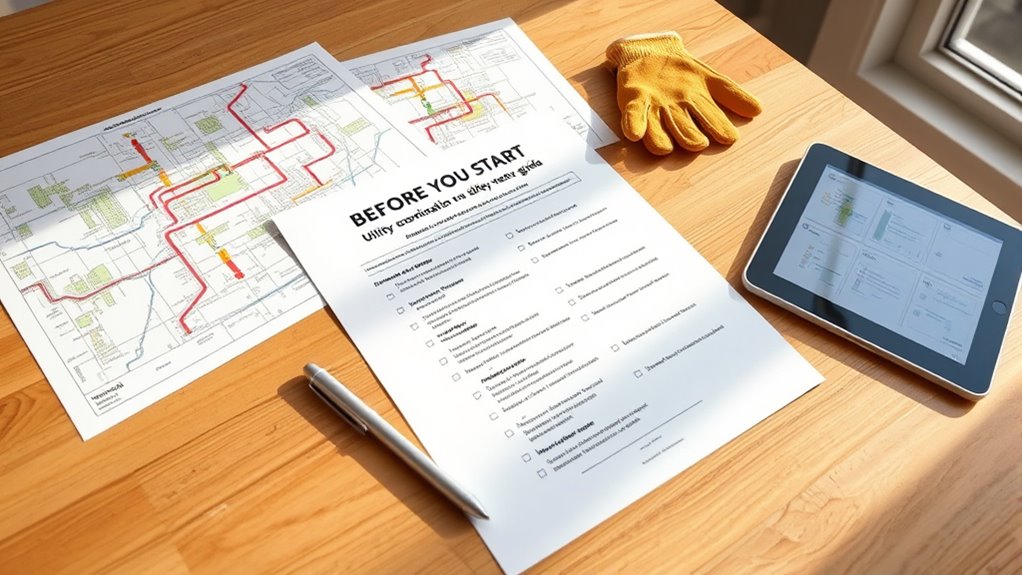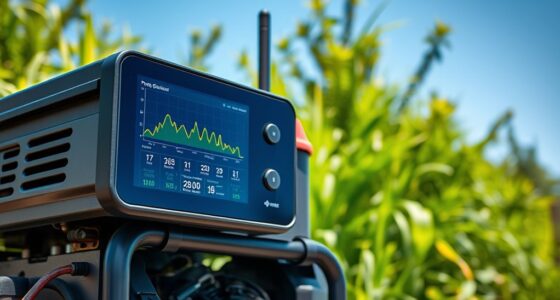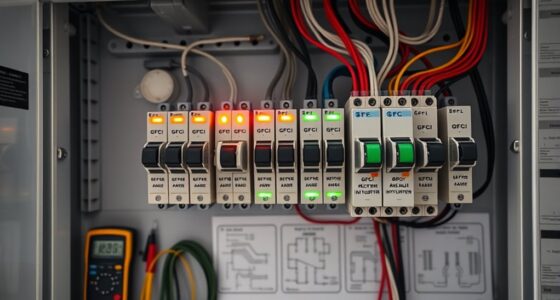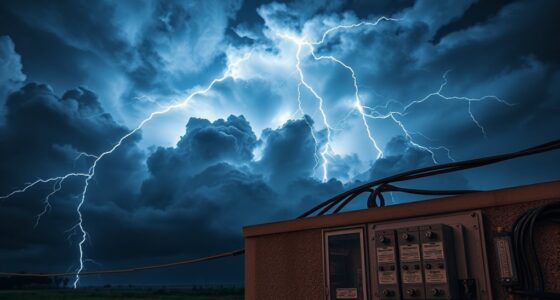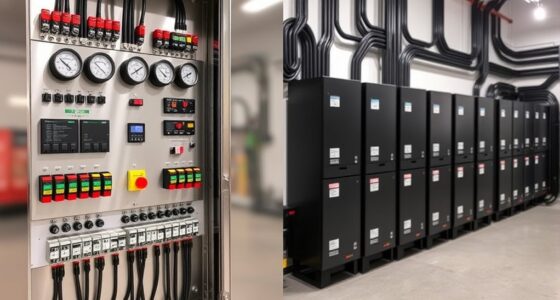Before you start, develop a detailed utility coordination and meter lock plan to prevent delays and stay compliant. Begin by clearly defining your project scope and understanding utility impacts. Contact utility providers early to confirm procedures for disconnections or lock removals. Review local regulations and permits to avoid legal issues. Schedule utility disconnections carefully, and keep thorough documentation of contacts and approvals. Follow these steps to ensure smooth progress—more tips await if you continue.
Key Takeaways
- Clearly define project scope and identify utility impacts early to prevent delays and ensure regulatory compliance.
- Engage utility providers early, confirm contact details, and establish communication protocols for seamless coordination.
- Plan disconnection and meter lock removal procedures in advance, aligning with project timelines and safety requirements.
- Schedule utility disconnections during operational hours to minimize disruptions and coordinate with all stakeholders.
- Document all utility arrangements, approvals, and communication for accountability and smooth project execution.
Assess Project Scope and Utility Requirements
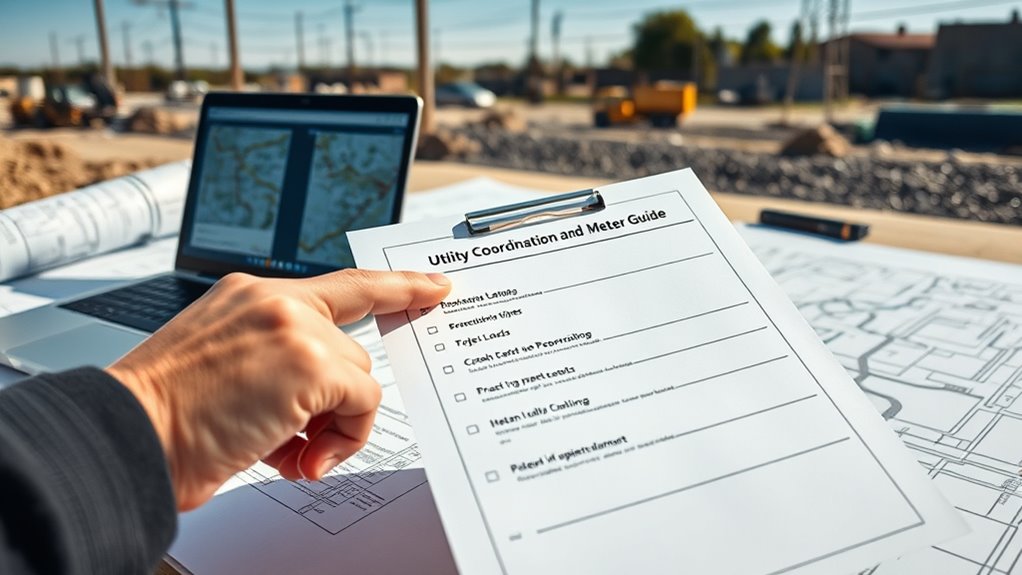
Have you clearly defined your project scope and identified all utility requirements early on? Doing so helps prevent surprises during construction. You need to understand how your project impacts utility billing and whether you’ll face potential service outages. For example, if your work involves extensive excavation or infrastructure modifications, it could disrupt water, gas, or electricity services. Identifying these needs upfront allows you to plan accordingly and coordinate with utility providers. This way, you can minimize downtime and avoid unexpected charges. By evaluating your project’s scope early, you ensure that utility requirements are incorporated into your timeline and budget. Recognizing the importance of utility coordination is essential for a successful project. This proactive approach reduces delays, keeps costs manageable, and ensures a smoother construction process.
Identify and Contact Utility Providers Early

Why wait until later to contact utility providers when early communication can safeguard you time and trouble? Reaching out early helps you understand utility billing processes and secure service agreements before construction begins. It also minimizes delays related to meter locks or service interruptions. By identifying utility providers early, you can coordinate schedules and ensure all necessary approvals are in place. Use this simple table to organize your contacts:
| Utility Provider | Contact Details | Notes |
|---|---|---|
| Electric Company | (555) 123-4567 | Confirm outage schedules |
| Water Service | (555) 987-6543 | Verify billing procedures |
| Gas Supplier | (555) 321-0987 | Discuss meter lock needs |
Early engagement ensures smooth utility operations and helps prevent costly surprises. Additionally, understanding utility regulations can help you stay compliant and avoid potential setbacks.
Review Local Regulations and Permitting Procedures

You need to understand local regulatory requirements to guarantee compliance from the start. Review the permit application process carefully so you can prepare all necessary documentation. Knowing these procedures early helps prevent delays and keeps your project on track. Additionally, familiarizing yourself with building codes and standards ensures your project meets safety and quality requirements.
Local Regulatory Requirements
Understanding local regulatory requirements is vital to guarantee your utility coordination and meter lock planning proceed smoothly. Regulations can impact utility billing, service outages, and access protocols. Failing to comply may cause delays or penalties. Before starting, review specific local ordinances, permits, and utility provider rules. Be aware of restrictions on meter locks, outage notifications, and billing procedures. Use the table below to understand key considerations:
| Regulation Area | Key Requirement | Impact on Planning |
|---|---|---|
| Utility Billing | Accurate account setup and billing | Prevents billing errors |
| Service Outages | Notification and outage protocols | Ensures minimal disruption |
| Meter Lock Regulations | Lock placement and access rules | Avoids compliance issues |
| Permitting Procedures | Required permits and approvals | Streamlines project timeline |
Additionally, understanding regulatory compliance is essential to avoid potential legal issues and ensure smooth project execution.
Permit Application Process
Have you reviewed the local regulations and permitting procedures required for your utility project? Understanding these steps is essential to guarantee smooth progress. You’ll need to submit permit applications that specify your project scope, including details about utility billing and service restoration plans. Check if permits are required from multiple agencies, such as city or state authorities, and note any specific documentation needed. Failing to follow proper procedures can cause delays or fines. Be prepared to coordinate with utility providers to confirm permit approvals before initiating work. Ensuring all permits are in place safeguards your project against legal issues and helps facilitate timely service restoration once work concludes. Staying compliant from the start minimizes disruptions and keeps your project on schedule. Additionally, being aware of cookie consent requirements can help you understand necessary disclosures related to your project’s online communications.
Plan and Schedule Utility Disconnections and Meter Locks
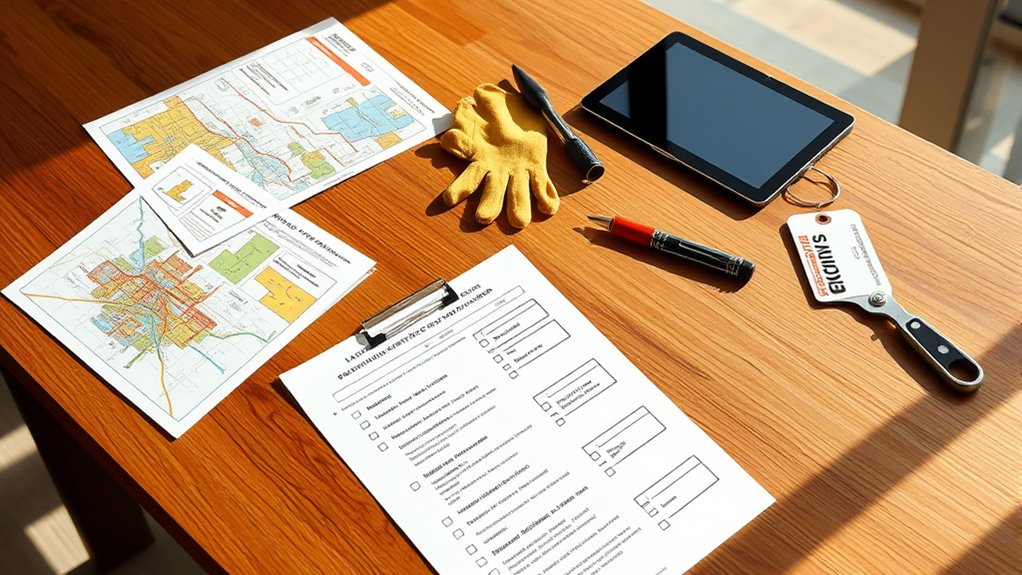
You need to coordinate utility notifications to make certain everyone is informed ahead of time. Next, set clear disconnection timelines that align with your project schedule. Finally, confirm the lock removal procedures to prevent delays and maintain safety throughout the process. Incorporating efficient ledger coding can assist in tracking utility-related expenses and ensuring accurate billing during disconnection activities.
Coordinate Utility Notifications
How can you guarantee utility disconnections and meter locks are effectively coordinated? The key is clear communication with utility providers. You need to notify them well in advance to avoid unexpected service interruptions that could impact utility billing or delay work. Confirm the exact disconnection dates and ensure they align with your project schedule. Providing detailed information about the scope and timing helps utility companies plan and execute disconnections smoothly. Also, request confirmation of receipt and understanding from each provider. Keeping everyone informed minimizes the risk of miscommunication, reduces potential delays, and ensures that meter locks are applied securely when needed. Proper notification planning helps you maintain control over utility service interruptions, avoiding costly surprises and keeping your project on track. Additionally, understanding the effectiveness of eye patches can help you choose the right skincare approach during project breaks or downtime.
Schedule Disconnection Timelines
Effective scheduling of utility disconnections and meter locks is essential to keep your project on track. You need to plan for a utility outage that aligns with your construction timeline, ensuring minimal disruption. Build in schedule flexibility to accommodate potential delays or unforeseen issues, such as permit approvals or weather impacts. Communicate your timeline clearly with utility providers, allowing enough lead time for disconnection requests. Confirm that disconnection and lock procedures are coordinated with all stakeholders to avoid conflicts or overlapping activities. Properly scheduled disconnections reduce the risk of project delays and ensure safety. Remember, precise planning helps you manage utility services efficiently, avoiding unnecessary downtime and keeping your project progressing smoothly. Utilizing load‑planning tools can further optimize your utility disconnection schedule and prevent overloads or outages.
Confirm Lock Removal Procedures
To guarantee smooth utility disconnections and meter lock removals, it’s crucial to confirm the procedures well in advance. Review the specific lock removal procedures provided by each utility company to verify compliance. Verify that safety procedures are clearly outlined and understood by all involved personnel. Confirm who is responsible for unlocking meters and removing locks, and schedule these tasks accordingly. Make sure any required permits or notifications are completed before the disconnection date. Communicate the planned procedures with your team to prevent delays and safety issues. Proper planning minimizes risks and ensures the lock removal process proceeds efficiently. Additionally, consider utility hours to ensure that scheduled disconnections occur during operational times, preventing unnecessary delays. By thoroughly confirming these procedures ahead of time, you help maintain safety standards and avoid costly disruptions.
Coordinate With Construction and Utility Teams
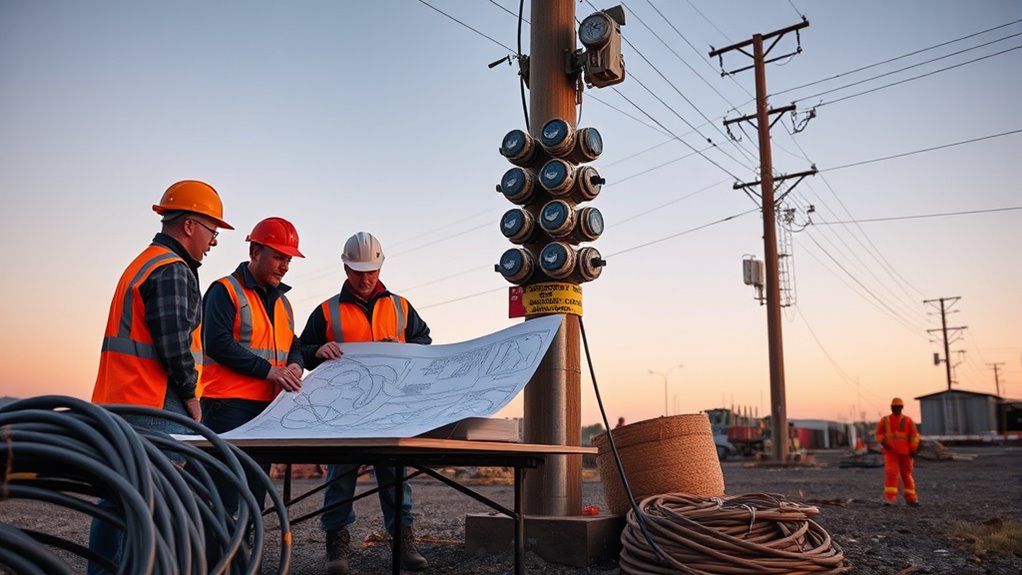
Coordinating with construction and utility teams is essential to guarantee smooth operations and prevent delays. You need to communicate early about planned service upgrades to ensure utility billing remains accurate and uninterrupted. Establish clear lines of communication with all parties involved, including contractors and utility providers. Share detailed project timelines and coordinate scheduled work to avoid conflicting activities that could disrupt service or cause meter lock issues. Confirm that utility companies are aware of upcoming construction to facilitate timely adjustments or shutdowns. This proactive approach helps prevent surprises, reduces downtime, and ensures that meter locks are managed correctly during construction phases. Effective coordination minimizes disruptions, keeps your project on schedule, and maintains proper utility billing throughout the process. Team structure and roles outlined can serve as a guide for defining responsibilities and points of contact during the coordination process.
Document and Confirm All Utility Arrangements
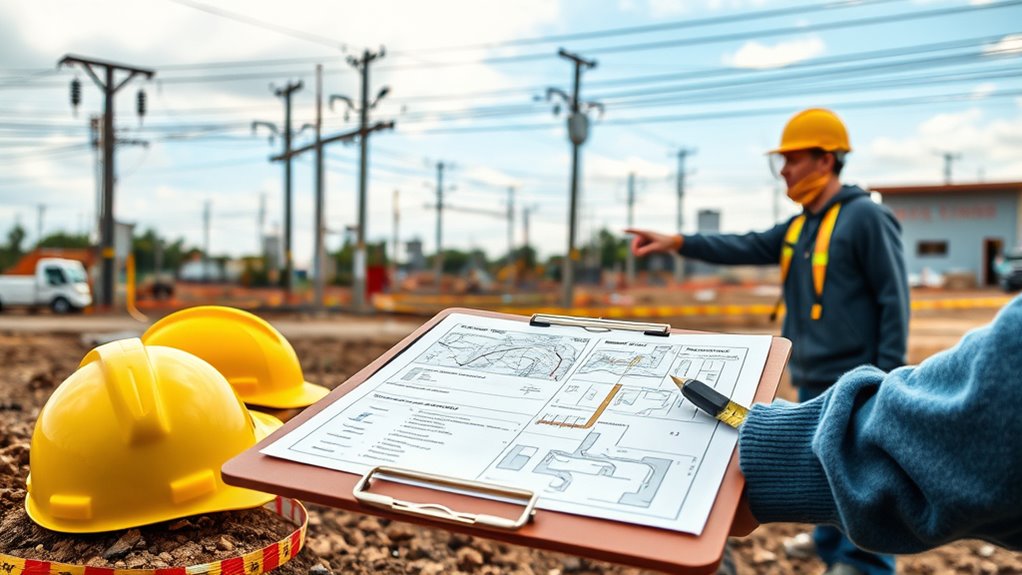
Before starting construction or service work, it’s essential to thoroughly document and confirm all utility arrangements. Verify utility billing details to ensure accurate charges and avoid surprises later. Confirm that utility providers have the correct contact information and understand your project timeline. If service upgrades are needed, coordinate these in advance to prevent delays. Clarify the scope of work with utility companies, including meter locks or access points, to ensure smooth operations. Keep detailed records of all agreements, approvals, and communication. Double-check that utility providers have scheduled any necessary service upgrades and confirm dates. This proactive approach minimizes disruptions, reduces the risk of billing errors, and guarantees all utility arrangements are aligned with your project’s requirements.
Frequently Asked Questions
How Do I Handle Unexpected Utility Conflicts During Planning?
If you encounter unexpected utility conflicts during planning, start by reviewing utility mapping to identify the exact location of utilities. Communicate promptly with utility providers to clarify the issue and explore conflict resolution options. Keep an open dialogue, document all interactions, and consider alternative solutions like rerouting or adjusting project plans. Staying proactive and collaborative helps resolve conflicts efficiently, minimizing delays and ensuring smooth project progress.
What Are Common Delays in Utility Coordination Processes?
Utility delays and coordination challenges often throw a wrench in your plans, causing unexpected setbacks. Common delays include miscommunications, incomplete documentation, and busy utility schedules. These hurdles can slow down your project timeline and cause frustration. To avoid surprises, stay proactive by maintaining open communication, verifying all paperwork early, and building buffer time into your schedule. Being prepared helps you stay on track despite the bumps in the road.
How Can I Ensure Compliance With All Local Utility Regulations?
To guarantee compliance with all local utility regulations, you should thoroughly review the relevant compliance standards before starting your project. Stay updated on any changes to utility regulations by consulting local authorities and utility companies regularly. Document all communications and approvals, and verify that your plans meet the required standards. This proactive approach helps prevent delays and ensures your project adheres to necessary utility regulations at every stage.
What Are Best Practices for Communicating With Utility Providers?
Establishing a seamless dialogue is key to effective utility communication and provider engagement. You should initiate contact early, clearly outline project timelines, and maintain consistent updates. Use professional language and active listening to build trust. Document all interactions, confirm details in writing, and promptly address any concerns. By fostering transparency and respect, you guarantee smooth collaboration, minimize delays, and uphold good relationships with utility providers throughout your project.
How Should I Document Changes During the Utility Coordination Process?
You should document changes during utility coordination by updating your utility mapping regularly to reflect new or altered utility locations. Keep detailed records of stakeholder engagement, including dates, contacts, and decisions made. Use clear, organized logs or digital files to track modifications and communications. This way, you guarantee everyone stays informed, reduces conflicts, and maintains an accurate record for project reference and future planning.
Conclusion
Think of utility coordination as guiding a ship through safe waters. By clearly charting your course—assessing requirements, contacting providers, and planning disconnections—you guarantee a smooth voyage. Each step is a lighthouse, illuminating the way and preventing surprises. When you document and confirm all arrangements, you anchor your project securely. With careful planning, you steer confidently toward completion, knowing you’ve navigated the essential currents of utility management to reach your destination successfully.
